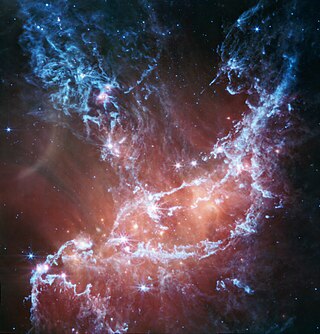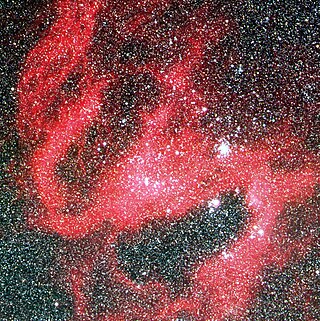
Wolf–Rayet stars, often abbreviated as WR stars, are a rare heterogeneous set of stars with unusual spectra showing prominent broad emission lines of ionised helium and highly ionised nitrogen or carbon. The spectra indicate very high surface enhancement of heavy elements, depletion of hydrogen, and strong stellar winds. The surface temperatures of known Wolf–Rayet stars range from 20,000 K to around 210,000 K, hotter than almost all other kinds of stars. They were previously called W-type stars referring to their spectral classification.

NGC 3603 is a nebula situated in the Carina–Sagittarius Arm of the Milky Way around 20,000 light-years away from the Solar System. It is a massive H II region containing a very compact open cluster HD 97950.

NGC 1569 is a dwarf irregular galaxy in Camelopardalis. The galaxy is relatively nearby and consequently, the Hubble Space Telescope can easily resolve the stars within the galaxy. The distance to the galaxy was previously believed to be only 2.4 Mpc. However, in 2008 scientists studying images from Hubble calculated the galaxy's distance at nearly 11 million light-years away, about 4 million light-years farther than previously thought, meaning it is a member of the IC 342 group of galaxies.

R136 is the central concentration of stars in the NGC 2070 star cluster, which lies at the centre of the Tarantula Nebula in the Large Magellanic Cloud. When originally named it was an unresolved stellar object but is now known to include 72 class O and Wolf–Rayet stars within 5 parsecs of the centre of the cluster. The extreme number and concentration of young massive stars in this part of the LMC qualifies it as a starburst region.

NGC 346 is a young open cluster of stars with associated nebula located in the Small Magellanic Cloud (SMC) that appears in the southern constellation of Tucana. It was discovered August 1, 1826 by Scottish astronomer James Dunlop. J. L. E. Dreyer described it as, "bright, large, very irregular figure, much brighter middle similar to double star, mottled but not resolved". On the outskirts of the cluster is the multiple star system HD 5980, one of the brightest stars in the SMC.

R136b is a blue supergiant star in the R136 cluster in the Large Magellanic Cloud. It is one of the most massive and most luminous stars known. It is found in the dense R136 open cluster at the centre of NGC 2070 in the Tarantula Nebula.

R136a1 is one of the most massive and luminous stars known, at nearly 200 M☉ and nearly 4.7 million L☉, and is also one of the hottest, at around 46,000 K. It is a Wolf–Rayet star at the center of R136, the central concentration of stars of the large NGC 2070 open cluster in the Tarantula Nebula in the Large Magellanic Cloud. The cluster can be seen in the far southern celestial hemisphere with binoculars or a small telescope, at magnitude 7.25. R136a1 itself is 100 times fainter than the cluster and can only be resolved using speckle interferometry.

HD 5980 is a multiple star system on the outskirts of NGC 346 in the Small Magellanic Cloud (SMC) and is one of the brightest stars in the SMC.

AB7, also known as SMC WR7, is a binary star in the Small Magellanic Cloud. A Wolf–Rayet star and a supergiant companion of spectral type O orbit in a period of 19.56 days. The system is surrounded by a ring-shaped nebula known as a bubble nebula.

R136a2 is a Wolf-Rayet star residing near the center of the R136, the central concentration of stars of the large NGC 2070 open cluster in the Tarantula Nebula, a massive H II region in the Large Magellanic Cloud which is a nearby satellite galaxy of the Milky Way. It has one of the highest confirmed masses and luminosities of any known star, at about 151 M☉ and 3.5 million L☉ respectively.

R136c is a star located in R136, a tight knot of stars at the centre of NGC 2070, an open cluster weighing 450,000 solar masses and containing 10,000 stars. At 142 M☉ and 3.8 million L☉, it is the one of the most massive stars known and one of the most luminous, along with being one of the hottest, at over 40,000 K. It was first resolved and named by Feitzinger in 1980, along with R136a and R136b.
HD 38282 is a massive spectroscopic binary star in the Tarantula Nebula, consisting of two hydrogen-rich Wolf-Rayet stars.

R136a3 is a Wolf–Rayet star in R136, a massive star cluster located in Dorado. It is located near R136a1, the most massive and luminous star known. R136a3 is itself one of the most massive and most luminous stars known at about 179 times more massive and 5 million times more luminous than the Sun.
BAT99-98 is a Wolf–Rayet star located in the Large Magellanic Cloud, in NGC 2070 near the R136 cluster in the Tarantula Nebula. At 226 M☉ and 5,000,000 L☉ it is one of the most massive and luminous stars currently known.

LMC195-1 is a Wolf–Rayet star located in the Large Magellanic Cloud (LMC). It is an extremely rare member of the WO oxygen sequence, at WO2 the hottest known in the LMC. It is likely to be one of the hottest stars known.

AB8, also known as SMC WR8, is a binary star in the Small Magellanic Cloud (SMC). A Wolf-Rayet star and a main sequence companion of spectral type O orbit in a period of 16.638 days. It is one of only nine known WO stars, the only Wolf-Rayet star in the SMC not on the nitrogen sequence, and the only Wolf-Rayet star in the SMC outside the main bar.

LH 41-1042 is a Wolf–Rayet star located in the Large Magellanic Cloud (LMC). It is an extremely rare member of the WO oxygen sequence, the second to be discovered in the LMC and one of only three found so far in that galaxy.











